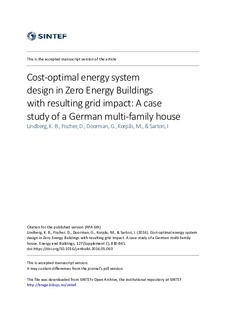Cost-optimal energy system design in Zero Energy Buildings with resulting grid impact: A case study of a German multi-family house
Journal article, Peer reviewed
Published version
Permanent lenke
http://hdl.handle.net/11250/2464189Utgivelsesdato
2016Metadata
Vis full innførselSamlinger
- Publikasjoner fra CRIStin - SINTEF AS [5866]
- SINTEF Community [2272]
Sammendrag
Zero Energy Buildings (ZEBs) are considered as one of the key elements to meet the Energy Strategy of the European Union. This paper investigates cost-optimal solutions for the energy system design in a ZEB and the subsequent grid impact. We use a Mixed Integer Linear (MILP) optimisation model that simultaneously optimises the building’s energy system design and the hourly operation. As a ZEB have onsite energy generation to compensate for the energy consumption, it is both importing and exporting electricity. The hourly time resolution identifies the factors that influence this import/export situation, also known as the building’s grid impact. An extensive case study of a multi-family house in Germany is performed. The findings show that the energy system design and the grid impact greatly depend on the ZEB definition, the existing policy instruments and on the current energy market conditions. The results indicate that due to the feed-in-tariff for PV, the cost-optimal energy design is fossil fuelled CHP combined with a large PV capacity, which causes large grid impacts. Further, we find that heat pumps are not a cost-optimal choice, even with lower electricity prices or with increased renewables in the electric power system.
Utgiver
Elsevier B.V.Tidsskrift
Energy and BuildingsOpphavsrett
© 2016 Elsevier B.V. All rights reserved. This is the authors' accepted and refereed manuscript to the article, post-print. Released with a Creative Commons Attribution Non-Commercial No Derivatives License. The final publication is available at https://doi.org/10.1016/j.enbuild.2016.05.063
Med mindre annet er angitt, så er denne innførselen lisensiert som Attribution-NonCommercial-NoDerivatives 4.0 Internasjonal
Beslektede innførsler
Viser innførsler beslektet ved tittel, forfatter og emneord.
-
Energy measurements at Skarpnes zero energy homes in Southern Norway: Do the loads match up with the on-site energy production?
Sørensen, Åse Lekang; Imenes, Anne Gerd; Grynning, Steinar; Dokka, Tor Helge (Journal article; Peer reviewed, 2017)Five houses are designed as zero-energy homes in Skarpnes, Norway. The energy goal is to achieve net zero-energy balance on an annual basis. The houses have heat pumps and solar cells (PV). Energy use and delivered energy ... -
A coordinated control to improve energy performance for a building cluster with energy storage, EVs, and energy sharing
Huang, Pei; Zhang, Xingxing; Bales, Chris; Persson, Tomas (SINTEF Proceedings;5, Chapter; Peer reviewed; Conference object, 2020)Existing studies have developed some advanced controls for energy storage system charging/discharging in a building cluster (enabling PV power sharing among different buildings), which can effectively improve the aggregated ... -
Hospital Equipment and Energy Usage. Applied Research by the Low Energy Hospitals Project, Norway
Rohde, Tarald; Martinez, Robert (SINTEF Rapport;A26100 DP3-01, Research report, 2014)A26100 - Report No DP3-01

